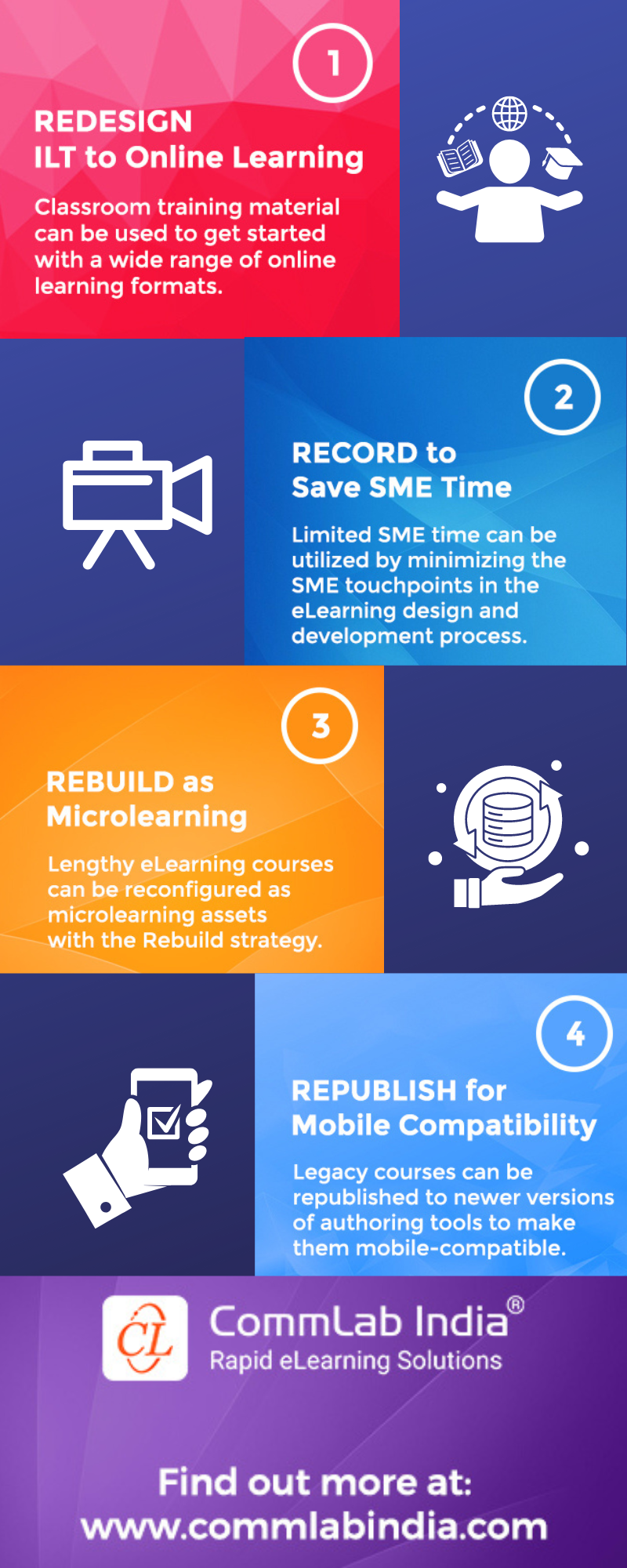Why Use Rapid eLearning for Corporate Training?

The fluid post-pandemic business landscape has made corporate training an indispensable business function. Regular training helps organizations close their skill gaps and improve their teams’ capabilities, so they can reap several benefits, such as enhanced productivity, reduced expenditure, and domain expansion, to name a few. However, to foster a culture of continuous learning, L&D teams need to employ rapid eLearning development tools and strategies for effective and consistent knowledge transfer.
The 4 Rs of Rapid eLearning Can Transform Your Corporate Training.
Here are the 4Rs of rapid eLearning:
- Redesign
- Record
- Republish
- Rebuild
Read on to explore how they can help you in effective corporate training.
Although virtual instructor-led training sessions and webinars have become smart alternatives to traditional classroom training sessions, eLearning courses are actively dominating the industry following the rise of powerful authoring tools in the market that enables quick development. Popular options include Adobe Captivate, iSpring Learn, and Lectora Inspire, to name a few.
As a result, rapid eLearning is proving to become the go-to solution for seamless, cost-effective, and hassle-free corporate training development and delivery.
Therefore, in this post, we’ll share everything rapid eLearning entails and different scenarios where L&D teams can use it to accelerate the learning curve and improve learning outcomes and ROI.
Rapid eLearning and the 4 Rs – The Key to Transformative Training
Due to the introduction of new technologies, work models, policies, and industry regulations, uninterrupted training has become a growing need for modern organizations looking to keep pace with the developments.
This is where rapid eLearning comes in as a method of developing or updating eLearning courses quickly using authoring tools to help learners improve their capabilities and adapt to the changes. Simply put, it offers high-quality corporate training programs and solutions at scale and speed, often using existing training content.

Here’s how rapid eLearning design can help you roll out your courses in no time.
Unlike traditional eLearning development, the rollout cycle is typically weeks, not months. To ensure a rich learning experience, L&D teams can use 4 Rs to transform or modify the learning content:
1. Redesign
Most traditional organizations have been opting for ILT sessions in the past. If you have done the same, then you’re most likely aware of the logistics costs they entail from commuting to accommodation, venue rental, printing, etc. Moreover, since the pandemic, classroom sessions are no longer the go-to option for businesses due to the 2020 lockdowns and closures that prompted them to look for alternatives.
Thus, redesign involves digitalizing your training process and material into:
- VILT sessions using videoconferencing solutions like Zoom, Webex, Adobe Connect, etc.
- eLearning courses using a powerful LMS for delivery, such as TalentLMS, Rippling, iSpring Learn, etc.
- Performance support material, such as microlearning videos, PDFs, FAQs, eBooks, and infographics.
These alternatives offer several benefits to learners, such as less routine disruptions, anywhere-anytime access, and near-real-time communication with peers and instructors. Similarly, it helps trainers reduce or eliminate the costs associated with traditional sessions.
2. Record
One of the biggest hurdles organizations face when developing courses is the non-availability of subject matter experts in different departments. This is usually due to busy core routines and multiple responsibilities that require their constant attention. However, when it comes to eLearning development, their input is often limited to reviewing the courses. Nonetheless, their involvement is crucial. Thus, you need to make the most of their available time.
This is where the Record strategy comes in to help minimize SME touchpoints during the rollout process, enabling you to quickly finalize and share your training course or content. Using this rapid eLearning method, SMEs simply have to put together a rough PowerPoint presentation encompassing everything from the course’s objectives, modules, and specific instructions.
From there, they can record every slide or topic in the deck using their phones or audio recording devices for the L&D team to use to create the new or updated eLearning course. The recreation or enhancement process could include microlearning video creation using tools like Vyond along or a narration script for podcasts.
Many teams with limited audio-visual capabilities or the resources to hire an external vendor to opt for creating simpler content, such as infographics, graphs, and charts using tools like Canva, Google Charts, Datawrapper, Infogram, etc.
3. Republish
If your organization and employees are no strangers to eLearning courses, you most likely have several old Flash-based courses that are no longer compatible with modern smartphones or authoring tools. Thus, the Republish aspect of rapid eLearning entails extracting relevant material from legacy courses to develop new courses instead of creating content from scratch every time.
Some also use this opportunity to simplify or optimize existing text-heavy courses with more visual elements to improve engagement and participation, especially when dealing with a younger, more tech-savvy workforce. Finally, another great use of rapid eLearning development is republishing the same content in multiple languages to cater to international employees.
The best tools for eLearning translation today include Lectora Inspire, Pairaphrase, and Articulate Rise.
4. Rebuild
Finally, we have Rebuild, which simply involves transforming old, lengthy eLearning courses into small modules, more manageable modules for continuous learning or just-in-time information. You can also use this opportunity to add new assessment techniques, such as gamified branching scenarios, simulations, digital flashcards, and other intriguing elements that beat the forgetting curve.
This approach helps save development time, resources, and costs. Moreover, it enables more targeted, concise learning for employees and provides them with real-time information instead of making them rely on retention and recall.
Using the 4 Rs of Rapid eLearning for Corporate Training – 3 Scenarios
Now that you understand the 4 Rs of rapid eLearning and their benefits, here are three scenarios where this agile training development approach comes in handy:
Employee Onboarding
Employee onboarding has become one of the most important L&D functions in the post-pandemic digital age due to increased turnover, remote hiring, and out-of-college recruiting. Like traditional onboarding, it involves offering recruits a glimpse of your workplace culture and helping them acclimatize to their daily tasks and responsibilities while adhering to rules and policies.
Rapid eLearning offers a great way to accelerate the learning curve. While training typically kicks off with a virtual or in-person training session or orientation, you can complement them with a short course encompassing your training objectives, content (videos, images, text), and assessments (scenarios, quizzes, and simulations). This way, you can quickly introduce new ideas and concepts cost-effectively.
Compliance Training
Rules are one of the few forces keeping operational chaos at bay. However, since they’re constantly changing due to micro or macroeconomic factors, businesses need to constantly update their teams with the new laws and regulations.
This is where rapid eLearning can come in to help accelerate compliance training by enabling L&D teams to update existing policy-related courses quickly using cutting-edge learning solutions, such as gamification, storytelling, and scenario-based learning for engagement enhancement.
Sales Training
If there’s one department that can change the dynamics of your workplace culture and bottom line from training, it’s your sales department. By frequently improving your sales team’s capabilities, you can enable them to generate more sales, retain more customers, and increase your revenue.
However, sales training can be quite broad, not just because of the multitude of products and services in the market, but also the training needs of your team. For instance, modern sales teams utilize different software solutions and tools to engage with consumers and store their information. Moreover, they employ different tactics to help understand and engage clients.
Thus, using rapid eLearning, you can develop eLearning courses for different aspects of your sales operations, such as:
- Explainer or how-to product and service videos
- Routine sales processes
- Soft-skills development
- Scenarios and dialogues for sales simulation training, etc.
It’s a Wrap!
So, there you have it – everything you need to know about the 4 Rs of rapid eLearning, including the benefits they offer for trainers, learners, and organizations. With this information, you can thoroughly assess your corporate training program and determine which aspects of this quick and agile development approach you can benefit from.
Whether you’re looking to transition from ILT sessions to eLearning, convert chunky courses into microlearning content, or translate your content to cater to your diverse workforce, you can leverage different rapid eLearning development tools to enhance your learning outcomes and training ROI.
Are you ready to implement Rapid eLearning to meet your organization’s training needs? Here’s a comprehensive guide that can help you embark on your journey. Get your hands on this free eBook now!
Editor’s note: This post was originally published in July 2022 and has been updated for comprehensiveness.





